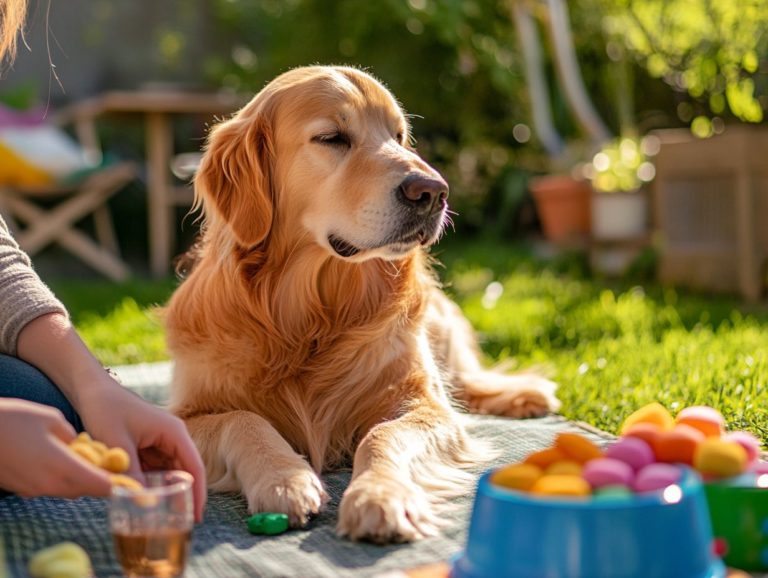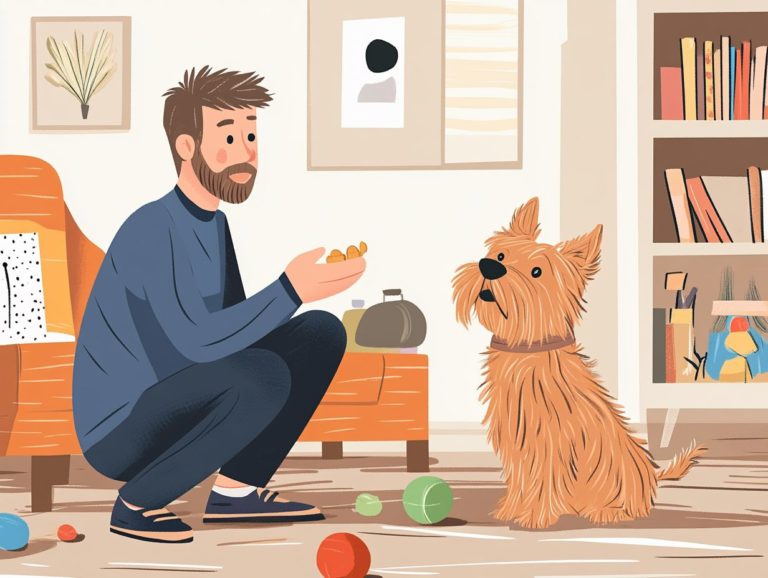Effective Commands for Calming Anxious Dogs
Anxiety in dogs is a big challenge for both pets and their owners. Understanding what causes this anxiety and its symptoms is the first step to helping your furry friend feel better.
In this article, we ll look at effective training techniques like rewarding good behavior and desensitization. You ll learn how to use specific commands to calm your dog and discover strategies like exercise and natural remedies that can help manage energy levels.
Embark on this journey with us to cultivate a calmer atmosphere for your anxious companion, ensuring their well-being and comfort.
Contents
- Key Takeaways:
- Understanding Anxiety in Dogs
- Training Techniques for Calming Anxious Dogs
- Using Commands to Calm Anxious Dogs
- Other Strategies for Calming Anxious Dogs
- Frequently Asked Questions
- What are some effective commands for calming anxious dogs?
- How can I teach my dog these calming commands?
- Can I use these commands in any situation where my dog is anxious?
- Are there any other techniques that can calm an anxious dog?
- Can these commands also work for other behavior issues in dogs?
- What should I do if my dog is not responding to these commands?
Key Takeaways:
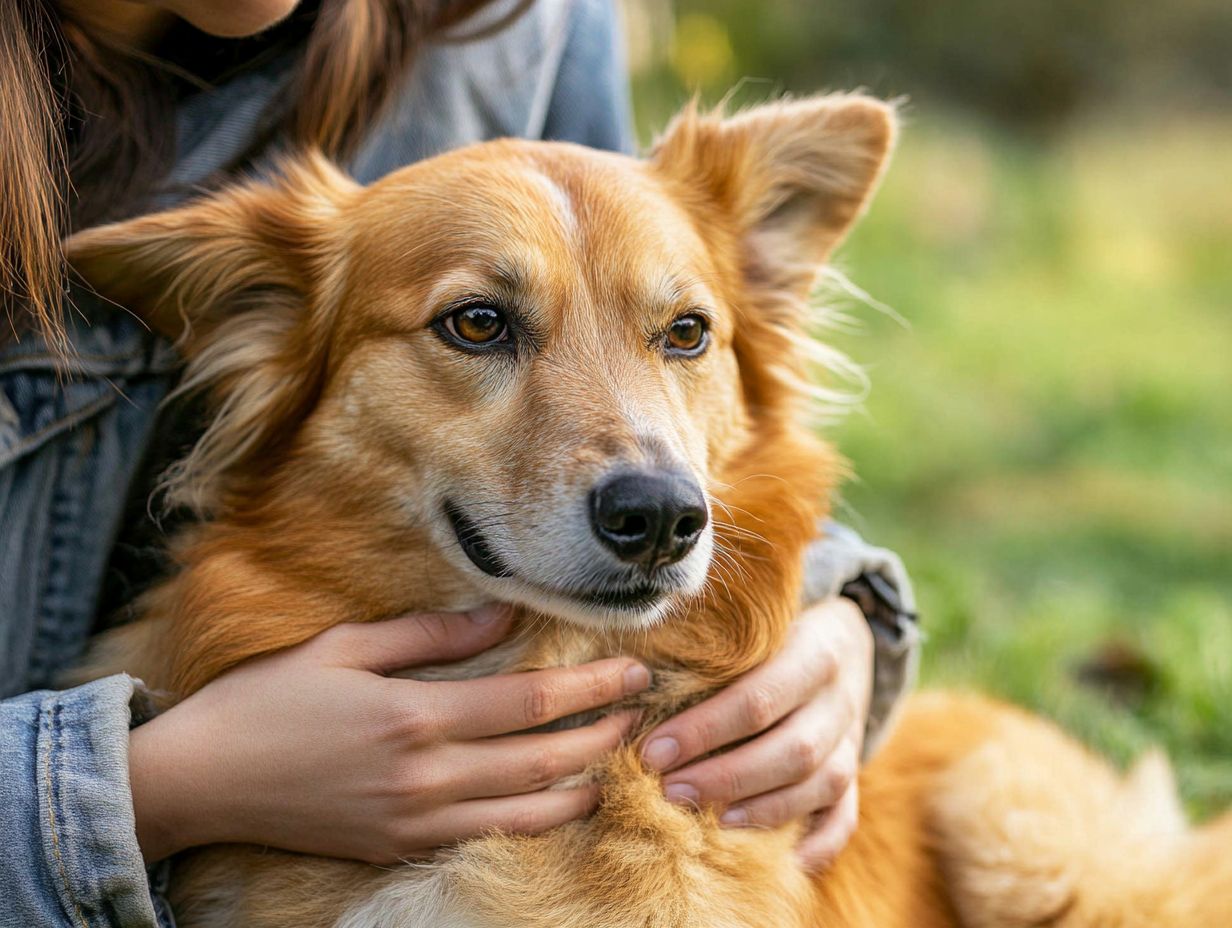
Understanding Anxiety in Dogs
Understanding anxiety in dogs is crucial for dog owners. It can greatly affect your pet’s happiness and behavior.
In Washington, DC, you can turn to professional dog trainers like Toni Woods, who specialize in tackling various anxiety-related issues, including separation anxiety and other behavioral challenges.
Recognizing the signs and symptoms of anxiety triggers is the critical first step in ensuring your dog remains a calm and joyful companion.
Causes and Symptoms of Anxiety
Many factors can lead to anxiety in dogs. Loud noises or changes in daily routines can unsettle them, resulting in noticeable behavioral symptoms.
Past traumas, whether from abuse or changes in their previous living situations, can profoundly impact your dog’s emotional well-being. You might see behavioral issues such as excessive barking, clinginess, or destructive actions when left alone. This highlights the importance of creating a calm environment to alleviate their distress and support their overall happiness.
Training Techniques for Calming Anxious Dogs
Training techniques that calm anxious dogs are vital for owners. Professional trainers like Toni Woods emphasize utilizing obedience training to ease anxiety by rewarding good behavior to manage anxiety triggers.
By adopting structured training methods, you can foster a more tranquil demeanor in your pet, paving the way for a happier and more harmonious household.
Positive Reinforcement Methods
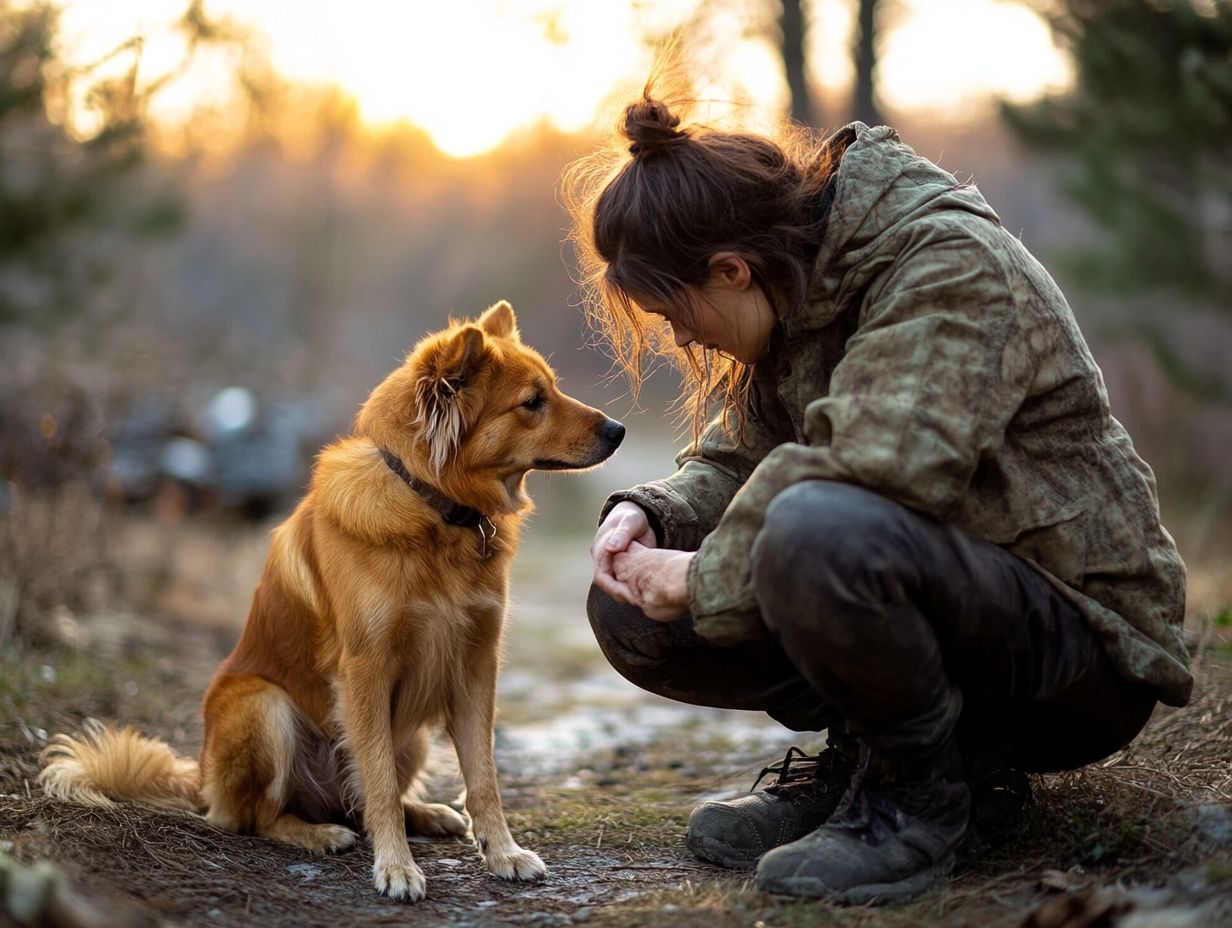
Positive reinforcement is a powerful way to train dogs with anxiety. By rewarding desired behaviors, you build a trusting relationship with your pet.
For example, when you use commands like “leave it,” rewarding your dog with treats or praise when they successfully ignore distractions can greatly enhance their impulse control.
Introducing a “quiet command” can also help your dog learn to calm down in various situations. The heart of this training approach is teaching your dog that remaining calm and focused leads to positive outcomes. For more effective methods, consider using clicker training for anxious dogs, fostering a less anxious demeanor while making the overall learning experience smoother.
Desensitization and Counterconditioning
Desensitization and counterconditioning are essential techniques for managing your dog’s anxiety triggers. For instance, using music to calm anxious pets during training can be an effective method. These approaches take a structured path, gradually exposing your dog to stimuli that typically cause anxiety, all within a safe and controlled environment.
By introducing the trigger at a low intensity while providing positive reinforcement, you can help your dog learn that these situations are not only manageable but can also lead to enjoyable experiences. For example, when facing loud noises or unfamiliar environments, using calming strategies such as treats, toys, or praise can greatly enhance your training efforts.
Over time, this systematic exposure will foster a more relaxed and calm demeanor in your dog, giving them the power to confront their fears with newfound confidence.
Using Commands to Calm Anxious Dogs
Effectively utilizing verbal commands can profoundly impact your ability to calm anxious dogs in stressful situations. Understanding basic commands for anxious pets, like the Place Command and the quiet command, can redirect your dog’s focus, fostering a more serene demeanor.
By training your dog to respond to these powerful commands, you give them the power to better manage their anxiety across different environments. For more targeted strategies, consider exploring training techniques specifically for anxious breeds.
Effective Commands and How to Use Them
Effective commands are essential tools for soothing dogs and helping them overcome anxiety. By incorporating techniques like “leave it,” the “quiet command,” and the “Place Command,” along with techniques to calm anxious pets before training, you can create a more tranquil environment for your furry companions.
Each command serves a specific purpose, allowing dogs to focus better in various situations. For example, teaching “leave it” helps curb unwanted behaviors, while the “quiet command” effectively addresses excessive barking. The “Place Command” encourages dogs to settle in designated areas, reinforcing their sense of security.
To teach these commands effectively, break down each step, using positive reinforcement and consistent cues. This approach not only aids your dog’s learning but also helps build a better relationship between you and your canine companion.
Other Strategies for Calming Anxious Dogs
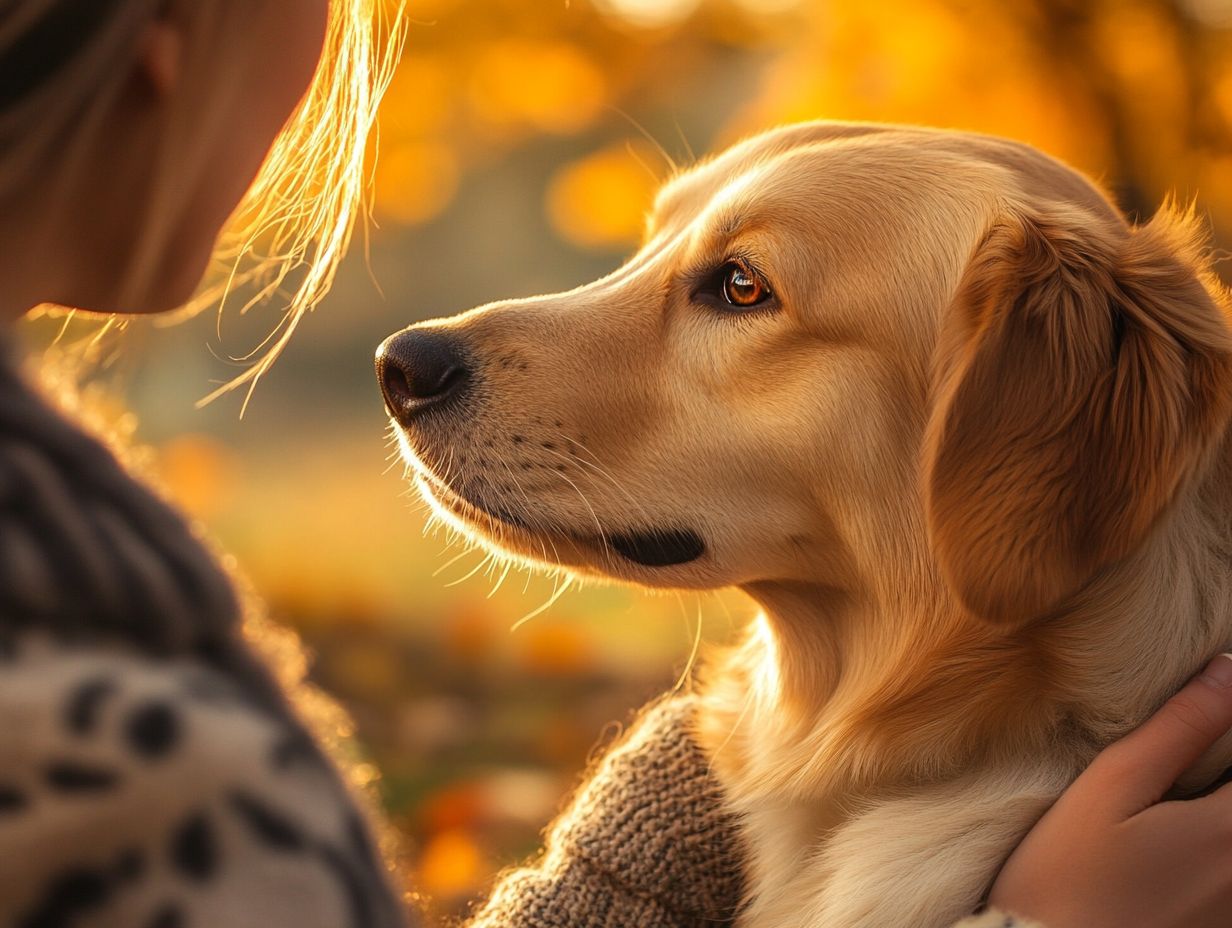
Discover a treasure of strategies! Beyond training techniques, you have a wealth of strategies at your disposal to effectively soothe anxious dogs and manage their high-energy levels.
By incorporating regular exercise and mental stimulation into your dog’s daily routine, you can dramatically reduce anxiety and mitigate behavioral issues.
You can also explore natural supplements that could play a vital role in creating a more tranquil environment for your beloved companion.
Exercise and Mental Stimulation
Regular exercise and mental stimulation are vital for nurturing a calm dog, particularly if your furry friend has a penchant for high-energy.
By weaving a variety of activities into their daily routine think brisk walks, spirited games of fetch, or even a splash in the pool you can effectively channel that abundant energy.
But don t stop at physical exercise; introducing puzzle toys is a fantastic way to engage their minds. Simple tasks like hiding treats or engaging in training sessions can challenge your dog mentally, promoting focus while minimizing reactive behaviors.
These combined activities not only help to ease anxiety triggers but also strengthen the bond between you and your dog, resulting in a more relaxed and balanced companion.
Environmental Enrichment
Environmental enrichment means creating a stimulating environment for your dog. Implementing environmental enrichment can significantly calm anxious dogs and alleviate various behavioral issues.
By creating safe spaces within your home, you can provide a retreat where your dog feels secure and relaxed.
Introducing interactive toys such as puzzle feeders and chewable gadgets will not only keep them entertained but also stimulate their intellect. Engaging activities like scent games and agility exercises further enhance their sensory experiences, leading to a more fulfilling life.
These thoughtful practices not only engage their minds but also promote relaxation, contributing to a serene environment that helps reduce anxiety levels, ensuring your furry companions feel more at ease.
Start applying these strategies today and watch your dog’s confidence grow!
Natural Supplements and Remedies
Natural supplements and remedies can be invaluable in helping your dog manage anxiety triggers. They provide essential support in stressful situations.
Options like CBD oil, chamomile, and valerian root are known for their soothing effects. These natural solutions can empower your dog to conquer anxiety!
While trainers use training techniques to reduce anxiety, adding herbal remedies boosts their effectiveness. This blend nurtures a healthier and more confident canine companion.
Frequently Asked Questions
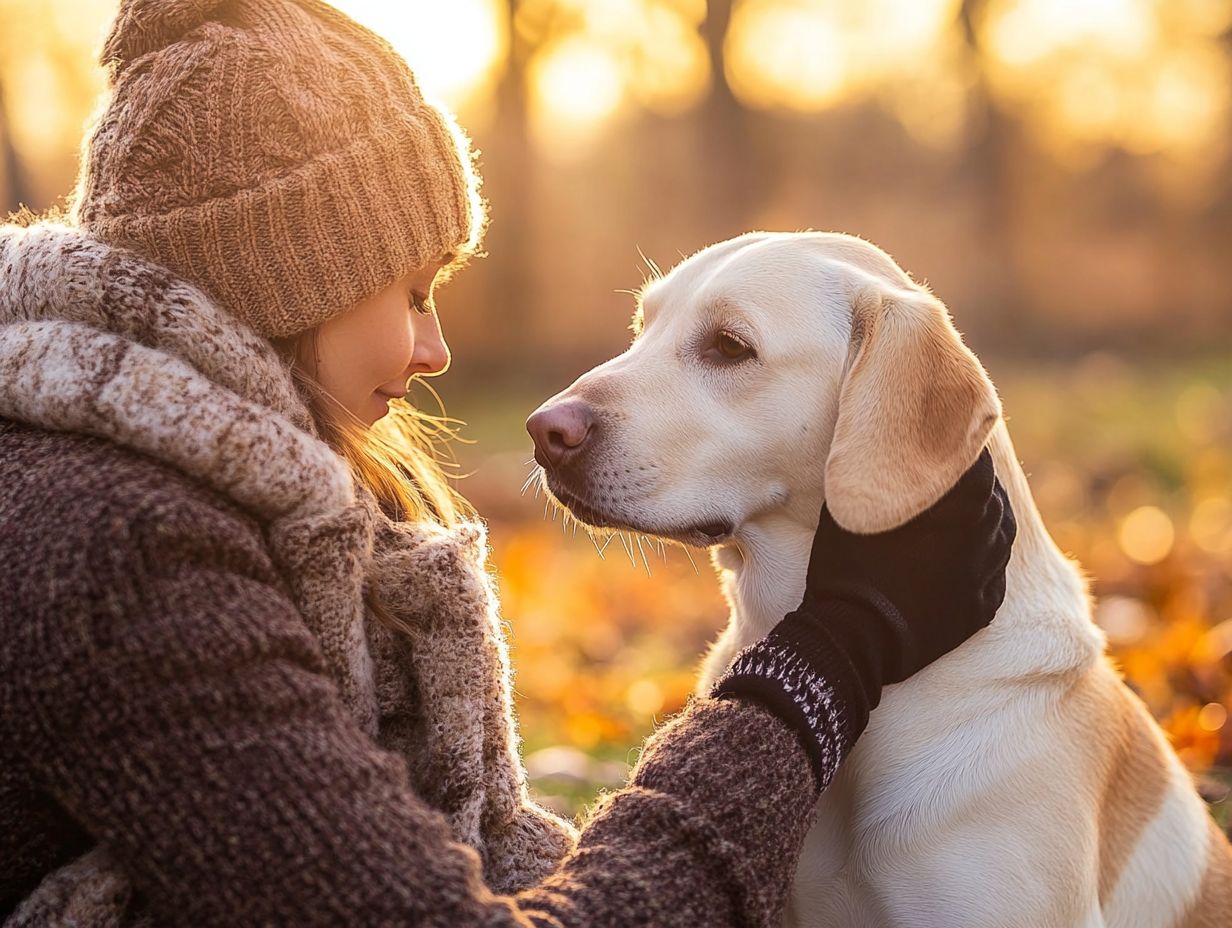
What are some effective commands for calming anxious dogs?
Commands like “sit,” “stay,” “leave it,” and “settle” can calm anxious dogs. Practicing these regularly helps your dog feel secure and can be part of how to encourage calm behavior in anxious pets.
How can I teach my dog these calming commands?
Use positive reinforcement to teach these commands. Reward your dog with treats or praise when they follow the command correctly.
Can I use these commands in any situation where my dog is anxious?
Yes, you can use these commands in various situations to calm your anxious dog. For more guidance, check out effective techniques for training anxious puppies. Regular practice helps your dog become familiar with them.
Are there any other techniques that can calm an anxious dog?
Besides commands, try techniques like deep pressure therapy, aromatherapy, and calming products for anxious pets. These can greatly help your dog relax.
Can these commands also work for other behavior issues in dogs?
These commands can also address issues like jumping, barking, and hyperactivity. However, it’s crucial to identify the root cause of these behaviors, and using aromatherapy to calm anxious pets can be an effective solution for anxiety-related problems.
What should I do if my dog is not responding to these commands?
If your dog doesn t respond, they may be too anxious or overwhelmed. Consult a professional dog trainer or behaviorist for guidance.

